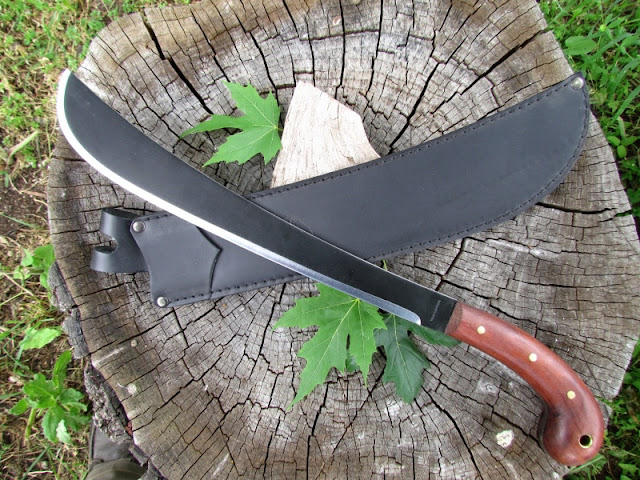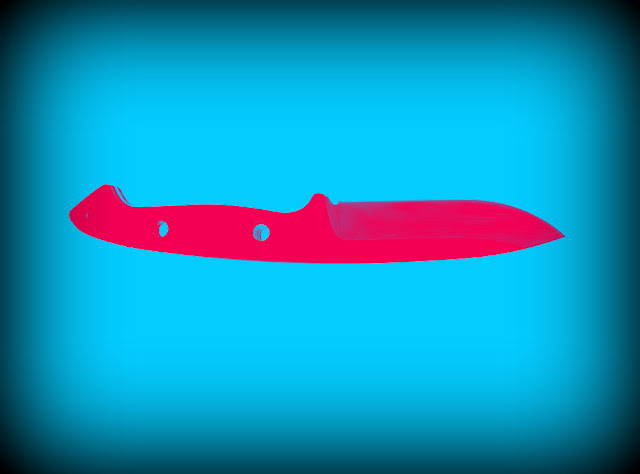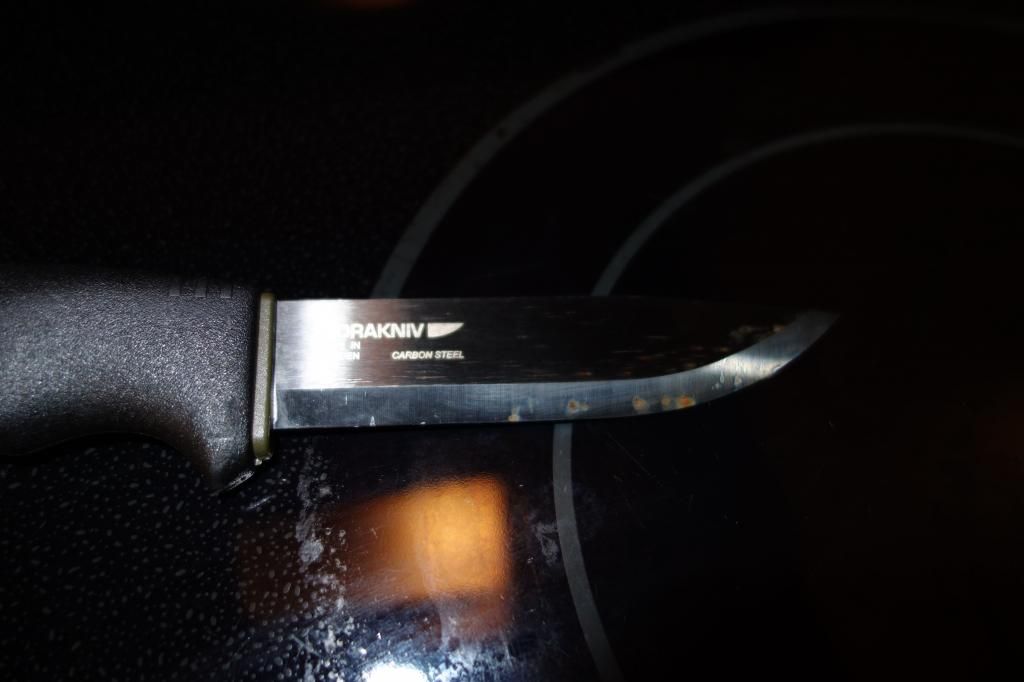Essay on Balance and Handle Shape with Reference the the Benchmade 162 Bushcrafter and the Golok Machete
I examined the Benchmade 162 Bushcrafter ("BMB") at two stores yesterday and took some pictures of it in my own hand. (The two hand-less photos in this post are not mine.) I want to discuss handle shape and balance, because the knife has been criticized--ignorantly, in my opinion--in some early video reviews on these two aspects. More generally, we haven't discussed fixed blade balance points in this thread and how handle shape relates to functional balance.
The first thing that has been criticized is the "pommel" on the end of the BMB's handle, which some say should be belt-sanded off (!). You can see the pommel in this picture, and also note the first hole because that is the BMB's balance point:
The second thing that's criticized is the size and placement of the BMB's palm swell. Some say that the palm swell should be smaller. Others say palm swells should always be centralized, and that the BMB's palm swell should therefore not be so far forward. Some say the handle is too narrow between the palm swell and pommel.
A third thing reviewers are confused about is the balance point. Some say the the BMB is blade heavy, some say it's handle heavy and, in general, many reviewers say a proper knife should have equal balance between blade and handle.
In my opinion, these critics don't understand the design philosophy of the BMB, especially as it relates to the kinesthetics of manual tool control and to functional balance.
Let's start with the actual balance point of the knife. It's at that first hole in the handle. I measured it by passing some line through the hole and dangling the knife. It's handle heavy. The question is why the designer chose to make it that way. The answer relates to the purpose of a "bushcraft" knife and, very specifically, to the the palm swell and the end pommel of the BMB's handle.
What's the purpose of a so-called bushcraft knife? It's supposed to be a do-it-all-reasonably-well knife for camping or surviving in the woods, including the abilities to do fine woodworking as well as free swing chopping. Given these two particular purposes, there are two relevant general principles. First, it's easier to control a knife for fine woodworking if it's handle heavy, because a lighter blade is easier to move around in three dimensions than a heavier one. Second, it's easier to generate free swing chopping momentum with a knife that's blade heavy, because momentum = mass x force, and the blade-heavy knife has more mass at the swinging end.
Now let's think like a designer. Which of these two balance-opposite purposes is more important, woodworking (handle heaviness) or free swing chopping (blade heaviness). In my opinion, free swing chopping with a 4"-5" knife is so relatively ineffective that you would never do it if you had a saw or axe. But the assumption is that you don't. Even so, baton chopping with a knife should usually be more effective than free swing chopping. Therefore, I am of the opinion that free swing chopping is a less important purpose than woodworking. I believe that Shane Sibert, the designer of the BMB, felt likewise. And that's why he placed the balance to make the BMB handle heavy. The notion that knives should be equally balanced between blade and handle is superficial nonsense. It all depends on the purpose of the knife.
Once Sibert made the balance point decision for the BMB, the design choices for the palm swell location and end pommel follow logically and kinesthetically.
What's the purpose of a palm swell in general? It relates to grip feel. More specifically, the kinesthetics of manual hand tools has shown that, within limits, a thicker hand grip can give finer tool control. That's the reason for palm swells on tools: to increase fine movement control. The next design issue is where to locate the palm swell. In the sacred middle? No! -- not when the knife is fairly big and the more important purpose is woodworking. The BMB's palm swell is large to increase manual control, and it's placed forward so you can choke up on the handle, which makes the knife "shorter" and gets the heavy part behind you to lighten the blade even more. When choked up, the palm swell is perfectly located to fill the middle of the hand. Like so:
Next, what's the purpose of the end pommel? In general, it prevents your hand from slipping back off the handle when swinging or chopping with the knife. But there's an additional purpose for a handle-heavy knife such as the BMB. Remember, such knives are at a chopping momentum disadvantage compared to blade-heavy knives, which have more mass at the swinging end. But also recall that momentum = mass x force, so you can generate more chopping momentum if you increase the knife's swing velocity.
How does a designer do that? Well, let's look at the ancient design of a wood-chopping machete, the golok -- for example this one (which I own) by Condor:

What's that bulbous knob at the end of the handle? Aesthetics? No, it's where you grip way down low to increase swing velocity and hence chopping momentum. By holding the handle as low as possible, you increase the "length" of the machete and move the center of swing mass further forward. At the same time, you let the knife pivot in your hand to generate even more swing velocity. You can do this effectively and safely when you have a bulb or pommel at the end of the handle. (Using a wrist lanyard with proper cross-thumb wrap increases safety.)
This is why Shane Sibert narrowed the BMB's handle below the palm swell and put an aggressive pommel on the end. To help compensate for the knife's handle-heavy balance point, there a safe pommel stop at the end of the handle, which is narrow enough above the pommel to get a two-finger grip wrapped tightly around for a high momentum free swing chop. Thusly:
That's my response to the internet critics of the BMB's balance point and handle geometry.
We've talked a lot about the Falkniven F1 and S1 in this thread. I strongly suspect both have the balance point more forward than the BMB and hence are relatively more blade heavy than the BMB. I say that because they have thicker blades than the BMB and Fallkniven has to remove metal off the top and bottom of the handle tangs to accommodate their 360 degree rubber-plastic grip. I'd love to hand test the comparative balance of the Fallknivens against the BMB, but I can't find any locally.
Of course, handle comfort is also a function of hand size. I'm 5-9 and wear a mens large glove size. Not choked up or down, but just holding the BMB in a neutral position, it felt very comfortable to me even with gloves.
The purpose of this post was to be informational and educational about the design relationship between knife balance and handle geometry, not about whether I liked the Benchmade 162 Bushcrafter. But . . . is that chain mail on my hand? . . . as I removed the BMB slowly from its sheath, I felt like King Arthur pulling Excalibur from the enchanted stone.
Last edited:







